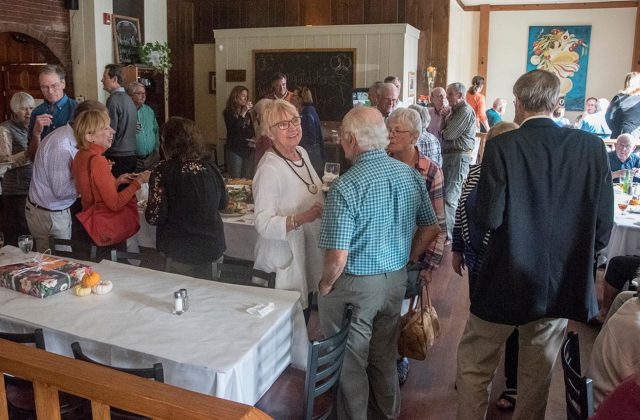Retirement Party Honors First Selectman Dyer
Counting the achievements of nearly two decades
By Wiley Wood
The tables and chairs were pushed back in the dining room at the Wood Creek Bar and Grill on a recent Sunday, and a broad cross-section of Norfolk residents were gathered around a banquet table to honor First Selectman Sue Dyer, who will step down on November 20 after 18 years in office.
Dyer replaced Arthur Rosenblatt in 1999, after serving as selectman during much of the 1990s. One of her initial successful projects as first selectman was to secure $1.2 million in federal grants to rehabilitate the senior housing center at Meadowbrook. Repairs to the building had been piecemeal, and the new construction addressed both interior and exterior shortcomings.
It was also in the early years of her tenure that Dyer managed to find grant money to construct a new building for the Public Works Department, a process complicated by the need to first hook up the town garage to the town water and sewer systems. Much of the machinery now sheltered by the large metal shed at the rear of the site was once permanently exposed to the weather.
The new ambulance barn was built on Dyer’s watch, and the crumbling sidewalks around the village green replaced with new bluestone, thanks to a $90,000 Small Town Economic Assistance Program grant from the state. “That was back when the state had money,” Dyer comments.
The town faced mounting debt from its pension program, and it was Dyer, working with Karen Sebach of the Pension Committee, who oversaw a shift from a paid benefit to a paid contribution system. “Today the defined benefit plan is solvent,” says Dyer.
Dyer has been willing to take difficult political decisions. At a time when the Norfolk Board of Education was unwilling to consider forming a new school district that would bring elementary students of Norfolk and Colebrook under one roof, Dyer championed the process. A two-year study resulted, a regional plan was created, and a vote was held. Although the regionalization bid failed—the residents of Colebrook voted against it—the effort was widely seen as a significant effort to address falling student enrollment and rising costs.
No issue has been more difficult for Dyer than the perpetual shortage of funds for town projects. “It’s not easy,” she says, “when you’re working with a lean budget and trying to make it leaner.”
During her tenure, Dyer has encouraged the formation of citizen groups working under the umbrella of Town Hall to promote specific projects. The hugely successful Norfolk Farmers Market, for instance, is formally a subcommittee of the town’s Economic Development Commission. Among other groups working out of Town Hall are the Rails to Trails Committee, which is trying to extend Norfolk’s trail system along parts of the existing railroad bed, and the City Meadow Committee, which has overseen the construction of City Meadow Park at virtually no cost to the town’s taxpayers—another grant obtained for the town by Dyer.
A native of Missouri who came to Norfolk as a young bride in 1969, Dyer will remain on the Board of Selectmen for the time being but plans to return soon to her home state to be with family. If that moment arrives before Dyer’s two-year term is up, the remaining two members of the Board of Selectmen will appoint another Democrat to replace Dyer.
“I’ve tried to serve the town well,” said Dyer at her retirement party, “and I hope I’ve managed to do that.”
Photo by Bruce Frisch:

